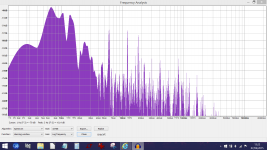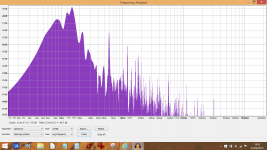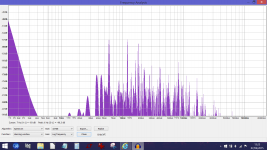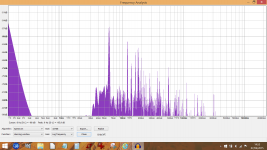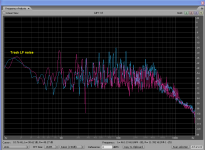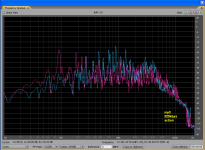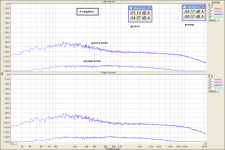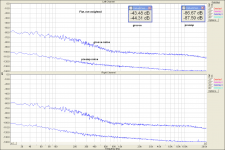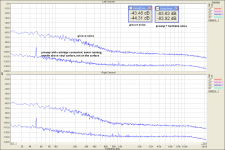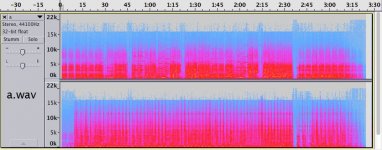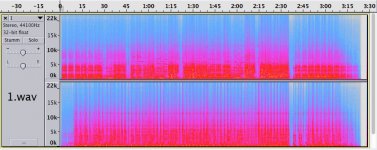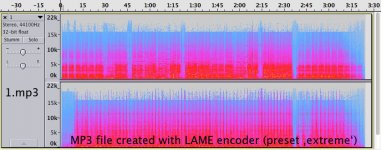I'm curious why 1.wav degrades in quality as it progresses through the track - Pavel, can you offer any explanation? As mentioned earlier I'm actually quite used to this behaviour, it was one of the biggest headaches I had in my early days of experimenting with digital playback; but since this is analogue playback captured, it could be an artifact from the turntable and record setup, or a time variant ADC behaviour.
If we do file analysis (which I don't), I believe "a" has many things to like. But if we can hear accurately, I believe "1" has more to offer.
But the higher resolution of "1" is a double-edge sword. It can be ruthless to the ears. Especially with recordings of such low quality.
Preference test is better performed with recording that is preferred by the participants, including the quality. So modern recording (such as Britney Spears) is more suitable than a vintage remaster.
Yes, "a" has many things to like, and "1" has more to offer in the way of surface noise, low frequency noise, low frequency rumble, reduced channel separation. All this with accurate hearing.
Pavel;
Thanks for the demonstration.
Oh no! I voted for 1.wav. 😱 Convinced it was CD. I thought it was cleaner, clearer and more defined. John Phillips' voice seems better defined as does some of the percussion. Overall cleaner and clearer. Rats! I thought that was the pure digital version.
Fooled me.
Fooled me.
Maybe because we remember original version from the sixties? The vinyl rip sounds closer to our memories than the digitized tape 🙂
And percussions may be deteriorated by 320kbps in the a.wav.
And percussions may be deteriorated by 320kbps in the a.wav.
Maybe. I just thought 1.wav inverted had more separation and space, less blur. A.wav sounded degraded in some way to me. Less distinct, dirtier.
I was careful NOT to listen for vinyl artifacts. Did not want to know which was which. Listening done on headphones with HRTF. Speakers out of commission at the moment.
I was careful NOT to listen for vinyl artifacts. Did not want to know which was which. Listening done on headphones with HRTF. Speakers out of commission at the moment.
A leading question 😉
Which would you have preferred Pavel, if you were doing the listening and with no means of looking at files.
I voted for a.wav, and that remains my firm choice. It has a cleaner and more rounded sound. Now it was only yesterday that I looked at the file content in Audacity and by total coincidence (nothing to do with this thread) another diy member suggested changing a default setting on the latest version of Audacity to highlight such things as vinyl rumble/surface noise etc. I even extracted the 1 second or so 'silence' at around 2:36:20 to 2:37:00 and copied it over and over to give a 10 second or so file in the hope of seeing cone movement (rumble) but there was just LF noise.
I can post the screen shots if you like.
Great test though Pavel and tbh, I was blown away that vinyl could sound this good (with such a quiet background). The one obvious limitation of a cartridge and vinyl is channel separation at hf and yet that just isn't noticeable as such, even with early stereo recordings such as this where they have greatly exaggerated L and R separation.
Which would you have preferred Pavel, if you were doing the listening and with no means of looking at files.
I voted for a.wav, and that remains my firm choice. It has a cleaner and more rounded sound. Now it was only yesterday that I looked at the file content in Audacity and by total coincidence (nothing to do with this thread) another diy member suggested changing a default setting on the latest version of Audacity to highlight such things as vinyl rumble/surface noise etc. I even extracted the 1 second or so 'silence' at around 2:36:20 to 2:37:00 and copied it over and over to give a 10 second or so file in the hope of seeing cone movement (rumble) but there was just LF noise.
I can post the screen shots if you like.
Great test though Pavel and tbh, I was blown away that vinyl could sound this good (with such a quiet background). The one obvious limitation of a cartridge and vinyl is channel separation at hf and yet that just isn't noticeable as such, even with early stereo recordings such as this where they have greatly exaggerated L and R separation.
A leading question 😉
Which would you have preferred Pavel, if you were doing the listening and with no means of looking at files.
I voted for a.wav, and that remains my firm choice. It has a cleaner and more rounded sound.
I prefer 1.wav, as it sounds to me more "natural" than the a.wav. No matter it has more noise. Maybe for the reason that Pano has mentioned and I followed.
I know all the technical issues of the vinyl, of that particular vinyl rip as well, I know the profile of the groove noise. Karl, no problem to go on and show results of your analysis.
There is just one area where vinyl rip is technically better than the true CD version (not the 320kbps used), and it is highs. I can demonstrate it later.
These were the shots from Audacity with the spectrograph set slightly differently from the defaults with '0' (as in the picture) being altered to '21' for the 'frequency gain db/dec' setting.
Attachments
True CD vs. vinyl rip:
(P.S.: Audacity is still not the best tool for the reason of limited possibilities of spectrum window setting)
(P.S.: Audacity is still not the best tool for the reason of limited possibilities of spectrum window setting)
Attachments
Last edited:
Interesting. That is a very different presentation of it and yet still showing the LF noise.
In Audacity I also noticed the two spikes at 60 and 120Hz but was surprised they were present on both versions. I thought anything like that would have been on the phono stage only. Seems to be on the master though.
In Audacity I also noticed the two spikes at 60 and 120Hz but was surprised they were present on both versions. I thought anything like that would have been on the phono stage only. Seems to be on the master though.
The a.wav spectrum - see the lame 320kbps action.
Yes, the tell tale sign of compression. (I still liked that one though 😛)
Interesting. That is a very different presentation of it and yet still showing the LF noise.
In Audacity I also noticed the two spikes at 60 and 120Hz but was surprised they were present on both versions. I thought anything like that would have been on the phono stage only. Seems to be on the master though.
No, I have 50Hz network here. 60Hz + 120Hz go from the master, from the US studio. My analog path is free of hum 😀
Yes - my guess was right 🙂
Thanks PMA for interesting thread time, and fun.
I was drop at Your site to recheck if there is something new,
(I want to see theese superb cabinets OB You designed again...)
and to went trough again all beautiful designs You have done
cheers and thanks for little effort to prepare the files. 🙂
Thanks PMA for interesting thread time, and fun.
I was drop at Your site to recheck if there is something new,
(I want to see theese superb cabinets OB You designed again...)
and to went trough again all beautiful designs You have done
cheers and thanks for little effort to prepare the files. 🙂
The groove noise is remarkably low, I still can't get over the fact that vinyl could be so quiet.
The groove noise is remarkably low, I still can't get over the fact that vinyl could be so quiet.
The groove noise is from different LP. It is just the minimum I get.
The last image is groove noise vs. preamp + turntable noise, turntable on.
You are right Karl, it is not easy to get these numbers.
Attachments
Instead of looking at a single spectrum, it is much more revealing to look at the spectrogram, where you can easily see that the MP3 encoder (most likely LAME, as I already wrote) cuts off at 16kHz once the signal gets loud enough. I encoded the vinyl track with LAME and got the same result (third image). The vinyl version seems to have a bit more high-frequency content; most likely because of noise, non-linear distortion and perhaps stylus resonance.
Why a "vinyl vs. MP3" comparison is called "vinyl vs. CD" is beyond me.
Why a "vinyl vs. MP3" comparison is called "vinyl vs. CD" is beyond me.
Attachments
Why a "vinyl vs. MP3" comparison is called "vinyl vs. CD" is beyond me.
It has not been important for the test. Everything is now revealed.
This is the sound of LAME residual (a.wav - CD Track03)
https://www.dropbox.com/s/lwrtvwlsuvyiulp/lame_action.wav?dl=0
(shorted)
https://www.dropbox.com/s/lwrtvwlsuvyiulp/lame_action.wav?dl=0
(shorted)
- Status
- Not open for further replies.
- Home
- General Interest
- Everything Else
- Listening test - do you prefer CD or vinyl version
